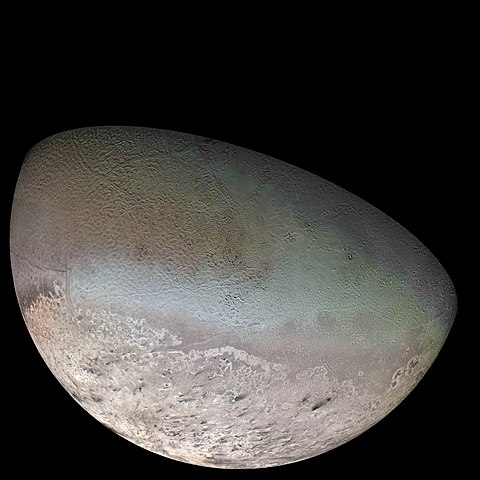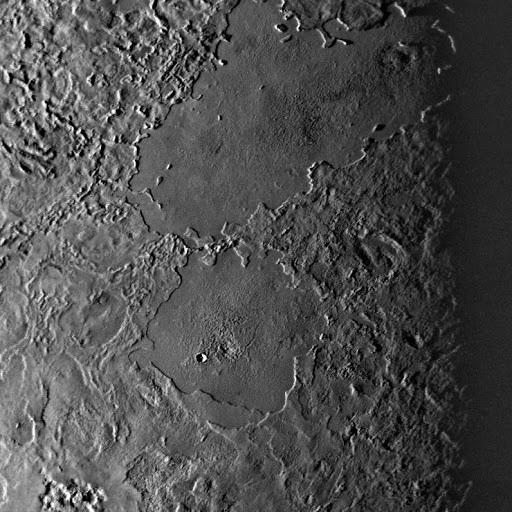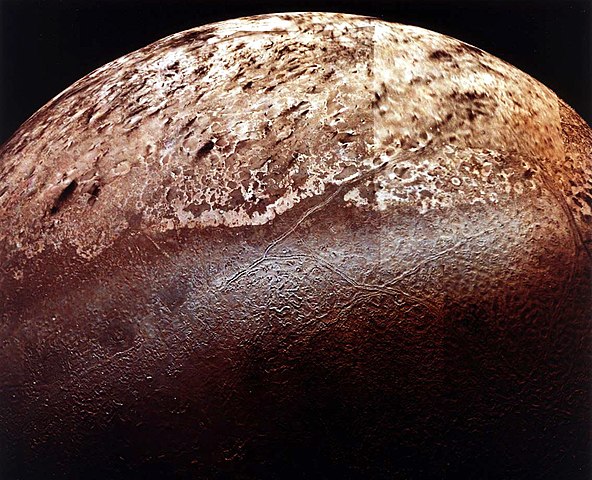Welcome to the mysterious world of Triton, Neptune’s chilly satellite that has captured the attention of scientists and astronomers alike. In this article, we will delve into the intriguing nature of Triton and reveal new information about this enigmatic moon.
From its discovery to its physical characteristics and recent findings, we will uncover the secrets of Triton and its place in our solar system.
So buckle up and get ready to embark on a journey through the icy terrain of Triton, as we unveil the mysteries of this distant moon.
Table of Contents
Discovery of Triton
Triton, the largest moon of Neptune, has long been a topic of fascination and mystery for astronomers and space enthusiasts. Discovered in 1846 by British astronomer William Lassell, Triton has since been the subject of numerous studies and observations, revealing new and intriguing information about this chilly satellite.

Triton was named after the Greek sea god, Neptune’s son, in accordance with the tradition of naming moons after mythological figures. The discovery of Triton was significant as it was the first satellite to be discovered after the invention of the telescope. At the time of its discovery, Triton was also the only known satellite of Neptune.
Aside from its historical significance, Triton has also caught the attention of scientists due to its unique characteristics. With a diameter of 2,700 kilometers, Triton is the seventh largest moon in the solar system. It is also the coldest known object in the solar system, with an average temperature of -235 degrees Celsius. This extreme cold is due to Triton’s distance from the sun, which is about 30 times farther than Earth’s distance.
Another intriguing feature of Triton is the presence of geysers and nitrogen ice on its surface. These geysers, which were first observed by NASA’s Voyager 2 spacecraft in 1989, shoot out dark particles up to 8 kilometers high. This phenomenon is believed to be a result of the sun’s heat melting the nitrogen ice, causing it to erupt into the thin atmosphere of Triton.
Thanks to the Voyager 2 flyby, scientists were able to gather more information about Triton’s physical characteristics and atmosphere. The spacecraft revealed that Triton has a thin atmosphere, mainly composed of nitrogen with trace amounts of methane and carbon monoxide. This discovery was a significant breakthrough in understanding Triton’s environment and how it interacts with its surroundings.
Despite the new information gathered by Voyager 2, Triton still holds many mysteries waiting to be unraveled. One of the biggest questions surrounding Triton is its retrograde orbit, which means it orbits Neptune in the opposite direction of Neptune’s rotation. This is highly unusual as most moons in the solar system orbit in the same direction as their planet’s rotation. Another mystery is Triton’s geological activity, which is still not fully understood.
To shed light on these mysteries, scientists have proposed various theories for Triton’s formation, including capture and collision theories. However, more research and exploration are needed to confirm these theories and uncover the true origins of Triton.
Fortunately, there are current and future missions in the works to explore Triton further. NASA’s proposed Trident mission aims to send a spacecraft to Triton in the next decade, providing new insights and discoveries about this enigmatic moon. However, exploring Triton is no easy feat. Its distance from Earth, combined with its extreme cold and thin atmosphere, present challenges for spacecraft missions.
In conclusion, the discovery of Triton in 1846 was just the beginning of our journey to understand this mysterious moon. With ongoing and future missions, we are slowly uncovering the secrets of Triton and gaining a better understanding of our solar system. Who knows what other surprises this chilly satellite holds for us in the future.
Physical Characteristics of Triton
Triton, one of the most intriguing moons in our solar system, orbits the distant planet of Neptune. With a diameter of over 2,700 kilometers, Triton is the seventh-largest moon in our solar system and the largest of Neptune’s 14 known moons. This icy satellite is a treasure trove of unique physical characteristics, making it a subject of great interest for scientists and space enthusiasts alike.
Triton’s composition is primarily made up of rock and ice, with a surface covered in a layer of frozen nitrogen, methane, and water ice. It is also believed to have a rocky core surrounded by a mantle of water and ammonia. What sets Triton apart from other moons in our solar system is its extremely low temperature of around -235 degrees Celsius, making it the coldest known object in our solar system.
The distance between Triton and Neptune is also noteworthy. Triton orbits Neptune at a distance of approximately 354,800 kilometers, making it the only large moon in our solar system with a retrograde orbit (opposite to the rotation of its planet) and the only known large moon to orbit in the opposite direction of its planet’s rotation. This unique characteristic has puzzled scientists for decades, with various theories proposed to explain this phenomenon.

One of the most significant and visually striking features of Triton is the presence of geysers and cryovolcanoes on its surface. These geysers, which were first discovered by Voyager 2 in 1989, are believed to spew out a mixture of liquid nitrogen, methane, and dust from Triton’s interior. This process creates a thin atmosphere around the moon, composed mostly of nitrogen, with traces of methane and carbon monoxide. The images captured by Voyager 2 also revealed a complex terrain of valleys, ridges, and impact craters, indicating a geologically active surface.
Thanks to the recent flyby of Voyager 2, we now have a more in-depth understanding of Triton’s atmosphere. The spacecraft’s instruments detected a thin layer of gas surrounding the moon, 70,000 times thinner than Earth’s atmosphere, and revealed that the atmosphere is primarily nitrogen, with traces of methane and carbon monoxide. This discovery has sparked new interest in studying Triton’s atmosphere and its possible interactions with Neptune’s magnetosphere.
Despite the numerous discoveries made about Triton, there are still many mysteries surrounding its origin and evolution. One of the most significant mysteries is the reason behind its retrograde orbit. Some scientists believe that Triton was once a dwarf planet in the Kuiper Belt and was captured by Neptune’s gravitational pull, while others propose that it was formed in a giant collision with another object. The exploration of Triton through future missions, such as NASA’s proposed Trident mission, is expected to shed more light on these unanswered questions.
In conclusion, Triton’s physical characteristics, including its size, composition, distance from Neptune, and unique features such as geysers and a thin atmosphere, make it a fascinating subject of study for scientists. Although there are still many unknowns about this chilly satellite, ongoing and future missions will surely bring us closer to unveiling its mysteries and unlocking the secrets of Neptune’s enigmatic moon.
Unveiling Triton’s Atmosphere
In addition to its unique physical features, Triton also has a fascinating atmosphere that has recently been unveiled through NASA’s Voyager 2 spacecraft’s flyby. This has provided scientists with valuable insights into the composition and characteristics of Triton’s atmosphere.
The flyby revealed that Triton has a thin atmosphere, much thinner than that of Earth’s. This atmosphere is primarily composed of nitrogen, with trace amounts of methane and carbon dioxide. This is surprising, as Triton is a frozen moon and was expected to have a more inert atmosphere. It has been suggested that the nitrogen may come from the melting of nitrogen ice on Triton’s surface, giving it a temporary atmosphere.
This discovery has raised many questions about the origin and evolution of Triton’s atmosphere. Scientists are still trying to understand how such a thin atmosphere can exist on a moon that is so cold and far from the sun. Some theories suggest that Triton’s atmosphere is a result of volcanic activity, which could release gases and maintain a faint atmosphere. However, no evidence of active volcanoes has been found on Triton, leaving this theory still a mystery.

Moreover, the thin atmosphere of Triton has also been found to be expanding and contracting, depending on its distance from the sun. This is due to the extreme tilt of Triton’s orbit, which causes it to experience varying levels of sunlight and temperature. This phenomenon has never been observed on any other moon in our solar system, making Triton truly unique.
Another intriguing aspect of Triton’s atmosphere is the presence of clouds and hazes. These were observed during the Voyager 2 flyby and have been confirmed through ground-based observations. These clouds consist of nitrogen and other organic compounds, giving Triton a hazy appearance. This further adds to the mystery surrounding Triton’s atmosphere, as it is unclear how these clouds form and what role they play in the moon’s climate.
The discovery of Triton’s atmosphere has opened up a whole new realm of questions and possibilities for further research. Scientists are eagerly awaiting future missions to Triton, such as the proposed Trident mission by NASA, in hopes of uncovering more information about this enigmatic moon.
In conclusion, the recent flyby of Triton by Voyager 2 has shed light on the unique and intriguing atmosphere of this Neptune’s moon. Its thin composition, varying density, and presence of clouds and hazes have left scientists with more questions than answers. But with advancements in technology and upcoming missions, we can hope to unravel the mysteries surrounding Triton and gain a deeper understanding of this chilly satellite.
Mysteries Surrounding Triton
Triton, the largest moon of Neptune, has captivated scientists and astronomers since its discovery in 1846. While it shares some characteristics with other moons in the solar system, Triton’s unique features and behavior have raised many unanswered questions and mysteries.
One of the most intriguing aspects of Triton is its retrograde orbit, meaning it orbits Neptune in the opposite direction of the planet’s rotation. This is a rare occurrence in our solar system and has puzzled scientists for decades. Some theories suggest that Triton was not originally a moon of Neptune, but instead was captured by the planet’s gravitational pull. However, this theory does not fully explain the moon’s highly inclined and elliptical orbit.
Another mystery surrounding Triton is its geological activity. Despite being a small, icy moon, Triton has a surprisingly active surface with geysers erupting from its south pole and nitrogen ice covering its surface. This is unexpected for a moon that is so far from the sun and receives little energy from it. Scientists have yet to determine the source of this activity, but it is believed to be linked to the moon’s unique orbital path and its proximity to Neptune.
The formation of Triton itself is also a subject of debate among scientists. Some theories propose that Triton was formed from the same gas and dust cloud as Neptune, while others suggest that it may have been a dwarf planet that was captured by Neptune’s gravitational pull. Another theory proposes that Triton was formed from a collision between two large objects in the Kuiper Belt, a disc of icy debris beyond Neptune’s orbit. However, these theories have not been fully proven, leaving the origin of Triton a mystery.
The recent discovery of Triton’s thin atmosphere has also raised questions about the moon’s past and present. The Voyager 2 spacecraft’s flyby in 1989 revealed that Triton’s atmosphere is primarily composed of nitrogen, similar to Earth’s atmosphere. This is unexpected for a small, icy moon and has led scientists to wonder if Triton once had a thicker atmosphere that was gradually lost over time.
To unravel these mysteries surrounding Triton, there have been proposed missions to explore the moon further. NASA’s planned Trident mission aims to send a spacecraft to orbit Triton, providing new insights and data to help answer questions about its origins and evolution. However, the extreme conditions and distance of Triton make it a challenging target for exploration.
In conclusion, Triton’s retrograde orbit, geological activity, formation, and atmosphere have all sparked scientific interest and raised many unanswered questions. While we have learned a great deal about this enigmatic moon, there is still much to discover and uncover. Future missions and research efforts will play a crucial role in unveiling the mysteries of Triton and expanding our understanding of this fascinating satellite.
Exploration of Triton
Despite its intriguing characteristics and potential for new discoveries, Triton remains a largely unexplored moon. However, there have been some missions in the past that have provided valuable insights about this chilly satellite. Let’s take a closer look at the current and future missions to explore Triton.
NASA’s Voyager 2 spacecraft, launched in 1977, made a historic flyby of Triton in 1989. This was the first and only close encounter with the moon to date. The spacecraft provided detailed images and data that revealed some of Triton’s physical features and composition. However, this flyby was brief and limited in its ability to gather comprehensive data.
In recent years, there have been discussions about potential missions to explore Triton in more detail. One such mission is NASA’s proposed Trident mission, which aims to send a spacecraft to orbit Triton and conduct a thorough study of the moon. This mission is currently in its early stages and is still being evaluated by NASA. If approved, the mission is expected to launch in the mid-2020s.
The Trident mission is expected to provide a wealth of new information about Triton, including its geology, atmosphere, and potential for life. The spacecraft will carry a suite of advanced instruments to study the moon’s surface and composition, as well as its atmosphere. This will allow scientists to gather data on Triton’s geysers, nitrogen ice, and other unique features in greater detail.
In addition to the Trident mission, there have been discussions about other potential missions to explore Triton. These include a proposed joint mission by NASA and the European Space Agency, as well as potential private missions by companies like SpaceX. These missions would further our understanding of Triton and potentially uncover new mysteries and discoveries.
However, exploring Triton comes with its own set of challenges and limitations. The moon is located nearly 3.6 billion kilometers from Earth, making it the farthest object ever visited by a spacecraft. This distance poses technical difficulties in terms of communication and travel time. Additionally, Triton’s extreme cold temperatures and low gravity present challenges for spacecraft operations.
Despite these challenges, the potential for new discoveries and insights about Triton makes it a highly anticipated destination for future missions. As technology and space exploration continue to advance, we can expect to learn more about this enigmatic moon and potentially answer some of the lingering questions surrounding its origin and nature.
In conclusion, the current and future missions to explore Triton hold great promise in expanding our knowledge and understanding of this chilly satellite. The data and observations gathered from these missions are crucial in piecing together the mysteries surrounding Triton and unlocking its secrets. As we continue to unveil the secrets of Neptune’s mysterious moon, Triton will no longer remain an enigma, but a fascinating world waiting to be explored.
